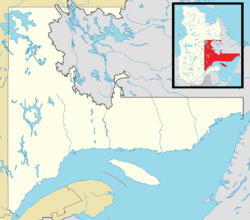Mingan, Quebec
| Mingan | |
|---|---|
| First Nations reserve | |
| Location in Côte-Nord region of Quebec. | |
| Coordinates: 50°18′N 64°02′W / 50.300°N 64.033°WCoordinates: 50°18′N 64°02′W / 50.300°N 64.033°W | |
| Country |
|
| Province |
|
| Region | Côte-Nord |
| Regional county | none |
| Formed | 1963 |
| Government | |
| • Chief | Jean-Charles Piétacho |
| • Federal riding | Manicouagan |
| • Prov. riding | Duplessis |
| Area | |
| • Total | 19.15 km2 (7.39 sq mi) |
| • Land | 16.89 km2 (6.52 sq mi) |
| Population (2006) | |
| • Total | 407 |
| • Density | 24.1/km2 (62/sq mi) |
| Time zone | EST (UTC-5) |
| • Summer (DST) | EDT (UTC-4) |
| Postal Code | G0G 1V0 |
| Area code(s) | 418 and 581 |
Mingan, also known as Ekuantshit in Innu-aimun, is an Innu First Nations reserve in the Canadian province of Quebec, at the mouth of the Mingan River on Mingan Bay of the Gulf of Saint Lawrence. It belongs to the Innu band of Ekuanitshit. Geographically it is within the Minganie Regional County Municipality but administratively not part of it.
The reserve is accessible via Quebec Route 138, 10 kilometers (6.2 mi) east of the village of Longue-Pointe-de-Mingan and 36 kilometers (22 mi) west of downtown Havre-Saint-Pierre. It is serviced by a health centre, community radio station, library, cultural centre, community store, municipal water and sewer system, fire station, and an aboriginal police force.
The name Mingan, already appearing as mican on a map of 1631, is generally considered to originate from the Innu word maikan, meaning "timber wolf". But there is no certainty over this interpretation. It has also been proposed that it may have come from the Basque word mingain meaning "language", or the Breton term menguen that translates as "white stone".
Historically, the region was the homeland of the Innu people, who came there from their inland hunting grounds to spend the summer on the coast. Mingan was a summer gathering site where the Innu would fish for salmon, hunt for whale, have family meetings, and trade with each other. In 1661 the Mingan Seignory was granted and Europeans began to settle in the area, marking the beginnings of the fur trade, which continued until the early 20th century. The North West Company and then the Hudson's Bay Company (from 1807 to 1873) maintained trading posts there under the name Mingan, which were frequently visited by Innu to trade furs, although they continued to stay there during the summers only.
...
Wikipedia

